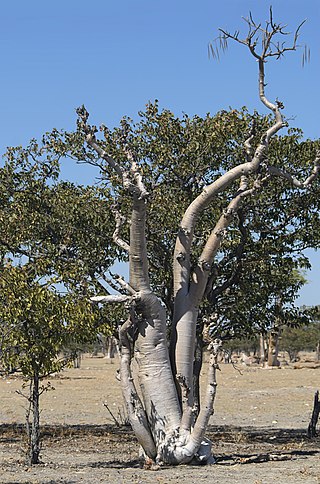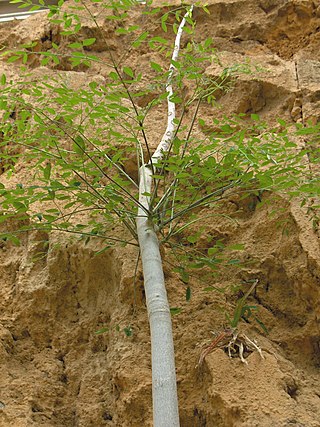
Euphorbia is a very large and diverse genus of flowering plants, commonly called spurge, in the family Euphorbiaceae.

The Aizoaceae, or fig-marigold family, is a large family of dicotyledonous flowering plants containing 135 genera and about 1,800 species. Several genera are commonly known as 'ice plants' or 'carpet weeds'. The Aizoaceae are also referred to as vygies in South Africa. Some of the unusual Southern African genera—such as Conophytum, Lithops, Titanopsis and Pleiospilos —resemble gemstones, rocks or pebbles, and are sometimes referred to as 'living stones' or 'mesembs'.

Moringa is the sole genus in the plant family Moringaceae. It contains 13 species, which occur in tropical and subtropical regions of Africa and Asia and that range in size from tiny herbs to massive trees. Moringa species grow quickly in many types of environments.

Cyphostemma juttae is a slow-growing succulent species of Cyphostemma from southern Africa, well known as an ornamental plant.

A plant cutting is a piece of a plant that is used in horticulture for vegetative (asexual) propagation. A piece of the stem or root of the source plant is placed in a suitable medium such as moist soil. If the conditions are suitable, the plant piece will begin to grow as a new plant independent of the parent, a process known as striking. A stem cutting produces new roots, and a root cutting produces new stems. Some plants can be grown from leaf pieces, called leaf cuttings, which produce both stems and roots. The scions used in grafting are also called cuttings.

Moringa oleifera is a fast-growing, drought-resistant tree of the family Moringaceae, native to the Indian subcontinent and used extensively in South and Southeast Asia. Common names include moringa, drumstick tree, horseradish tree, or malunggay.

Commiphora is the most species-rich genus of flowering plants in the frankincense and myrrh family, Burseraceae. The genus contains approximately 190 species of shrubs and trees, which are distributed throughout the (sub-) tropical regions of Africa, the western Indian Ocean islands, the Arabian Peninsula, India, and South America. The genus is drought-tolerant and common throughout the xerophytic scrub, seasonally dry tropical forests, and woodlands of these regions.

Mesembryanthemum is a genus of flowering plants in the family Aizoaceae, indigenous to southern Africa. As with many members of that family, it is characterized by long-lasting flower heads. Flowers of Mesembryanthemum protect their gametes from night-time dews or frosts but open in sunlight. There is an obvious evolutionary advantage to doing this; where sun, dew, frost, wind or predators are likely to damage exposed reproductive organs, closing may be advantageous during times when flowers are unlikely to attract pollinators.

Adenium obesum, more commonly known as a desert rose, is a poisonous species of flowering plant belonging to the tribe Nerieae of the subfamily Apocynoideae of the dogbane family, Apocynaceae. It is native to the Sahel regions south of the Sahara, tropical and subtropical eastern and southern Africa, as well as the Arabian Peninsula. Other names for the flower include Sabi star, kudu, mock azalea, and impala lily. Adenium obesum is a popular houseplant and bonsai in temperate regions.

The Giardini Botanici Hanbury, also known as Villa Hanbury, are major botanical gardens operated by the University of Genoa. They are located at Corso Montecarlo 43, Mortola Inferiore, several km west of Ventimiglia, Italy.

Moritz Kurt Dinter was a German botanist and explorer in South West Africa.

Gonialoe dinteri, the Namibian partridge aloe, is a species of flowering plant in the Asphodelaceae family. It is native to arid areas of Angola and Namibia.

Hoodia juttae is a species of plant in the family Apocynaceae. It is endemic to Namibia. Its natural habitats are rocky areas and cold desert. H. juttae is found around the Little and Great Karas mountains. It is threatened by collection. The plant was discovered by Jutta Dinter, the wife of botanist, Kurt Dinter in 1913. The scientific name refers to Jutta.

Hoodia ruschii is a species of stem succulent plant in the family Apocynaceae. It is endemic to Namibia. Its natural habitats are rocky areas and cold desert.

Moringa arborea is a species of flowering plant in the family Moringaceae that is endemic to Kenya.

In botany, succulent plants, also known as succulents, are plants with parts that are thickened, fleshy, and engorged, usually to retain water in arid climates or soil conditions. The word succulent comes from the Latin word sucus, meaning "juice" or "sap".

AnacampserosL. is a genus comprising about a hundred species of small perennial succulent plants native to Southern Africa, Ethiopia and Latin America. The botanical name Anacampseros is an ancient one for herbs supposed to restore lost love.

Moringa stenopetala, commonly known as the African Moringa or cabbage tree, is a deciduous tree in the plant genus Moringa, native to Kenya and Ethiopia. A drought-resistant species, it is characterized by its bottle-shaped trunk, long twisted seed pods, and edible leaves likened to cabbage, from which its common name is derived. M. stenopetala is extirpated in the wild in Ethiopia, though still grown there as a crop on the terraces of the Ethiopian Highlands, mainly in the Konso region.

Moringa hildebrandtii, or Hildebrandt's moringa, is a tree species with a massive, water-storing trunk in the family Moringaceae. It is endemic to Madagascar, where it is extinct in the wild, but preserved by indigenous horticulture practices.

The Fairy Tale Forest is situated in the Etosha National Park in the Kunene Region, Namibia, near Grünewald Farm. It is an open forest of Moringa ovalifolia.
























